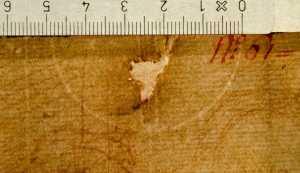Specifications
| Title | Salome Presents the Head of St John the Baptist to King Herod |
|---|---|
| Material and technique | Red chalk, framing lines with the pen in brown ink |
| Object type |
Drawing
> Two-dimensional object
> Art object
|
| Location | This object is in storage |
| Dimensions |
Height 218 mm Width 292 mm |
|---|---|
| Artists |
Copy after:
Andrea del Sarto (Andrea d’Agnolo)
Previously attributed: Giovanni Battista Naldini |
| Accession number | I 113 recto (PK) |
| Credits | Loan Stichting Museum Boijmans Van Beuningen (former Koenigs collection), 1940 |
| Department | Drawings & Prints |
| Acquisition date | 1940 |
| Creation date | in circa 1526-1600 |
| Watermark | crossbow or anchor (?) in circle (fragment, lower half, 25 x 49 mm, from P4 to 9P, vH) |
| Inscriptions | 'N:o 61=' (above centre, pen in purple ink, see provenance); 'Andrea del Sarto' (verso, above centre, pen and brown ink) |
| Collector | Collector / Franz Koenigs |
| Mark | Martelli (not in Lugt), F.W. Koenigs (L.1023a on removed fragment) |
| Provenance | Martelli family, Florence (not in Lugt); # (?) William Young Ottley (1771-1836, L.2642, L.2662, L.2663, L.2664, L.2665)***, London; - ; Franz W. Koenigs (1881-1941, L.1023a), Haarlem, acquired in 1926 (Andrea del Sarto); D.G. van Beuningen (1877-1955), Rotterdam, acquired with the Koenigs Collection in 1940 and donated to Stichting Museum Boijmans Van Beuningen |
| Exhibitions | Rotterdam 2009 (coll 2 kw 4) |
| Internal exhibitions |
De Collectie Twee - wissel IV, Prenten & Tekeningen (2009) |
| Research |
Show research Italian Drawings 1400-1600 |
| Literature | Frölich-Bum 1928, p. 170 (Del Sarto); Fraenckel 1935, pp. 195-96, no. 4 (copy after Del Sarto); Berenson 1938, no. 1761A (Naldini); Berenson 1961, no. 1766 A-1 (Naldini); Freedberg 1963, p.15; Barocchi 1965, p. 246, fig. 90c (Morandini); Shearman 1965, pp. 295-96 (copy late 17th or early 18th c.); Monbeig Goguel 2005, p. 398 (Vanni) |
| Material | |
| Object | |
| Geographical origin | Italy > Southern Europe > Europe |
Do you have corrections or additional information about this work? Please, send us a message
























